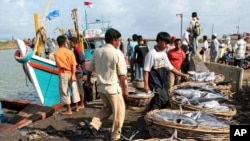China's soaring economy is also expanding the country's ecological footprint. As the Chinese middle class expands, more people can afford delicacies that used to be reserved for the lucky few. For example, Chinese consumers pay four to eight times more for the privilege of choosing their fish alive in restaurants’ fish tanks. But as demand rises for live reef fish, the seas in Southeast Asia are feeling the impact. On the Indonesian island of Sumatra, fishermen have developed aquaculture for grouper, to feed this market.
Herno Minjoyo paces slowly between the waist-high concrete fish tanks of Lampung’s hatchery. Hundreds of minuscule groupers, white with black spots, are fretting about. It’s the second generation that government specialists such as Herno, who’s been working here for more than ten years, have managed to breed.
Herno says that before, people did not know that the grouper was a fish worth looking for. It was like the lobster: in the village, people used to throw them away. But now that the price is high, people look for them.
Today fishermen can sell their panther groupers (known in Australia as barramundi cod) for $48 per kilo, as long as the fish are still alive once they reach the Chinese market.
Overfishing
Such high prices have led to overfishing and many species of reef fish particularly sought after in China, such as the grouper or the Napoleon wrasse, are in danger of disappearing, says Imam Mustohfa, Fisheries director for the World Wildlife Fund in Indonesia.
“Because the demand has increased now, they’ve expanded to the Philippines and also in Indonesia because the fish in Hong Kong is done already," Imam explained. "And now in Indonesia it has also started declining, so they’ve expanded to Australia and also in the Pacific ocean. So now there are 12 species of grouper in an endangered situation.”
In Lampung province, groupers have been rarely seen in the wild for the last 10 years. But, with the help of the government-run hatchery, fishermen have started a small aquaculture business exclusively geared towards providing live fish to the Chinese market.
Lani, who, like many Indonesians, goes only by one name, tried his luck four years ago. Today he owns four of the cages that float about 100 meters from Ringgung beach.
Aquaculture
On the platform, young men are cutting small fish to feed the groupers. Lani says that aquaculture is a tough job: 10 years ago, only a third of the fish managed to survive long enough to reach the standard plate-size that is most sought after by the Chinese. Today the survival rate has reached 70 percent, but the business remains risky.
Lani says that it takes at least 15 months before you can start earning an income from the fish. But, with big risk, comes a potentially big reward.
The fishing industry says one cargo plane leaves Jakarta for Hong Kong every day carrying one ton of live fish bred in Indonesia. Bangun Sitepu, the president of the Indonesian association of fish farmers, expects the demand to remain strong for years to come.
He says he is very optimistic. China is a big country, with an ever-improving economy and an ever-growing market for such delicacies as the grouper. So he says he is very confident in his future prospects.
But aquaculture only covers a fraction of the market. And the environmental non-governmental organization, World Wildlife Fund, says that catches in the wild are mostly unmonitored, and frequently involve destructive practices such as blast fishing, that destroys ecosystems.
“The grouper that are being sold live to China or Hong Kong are not mature, they’re not breeding yet," said Cut Desyana, the aquaculture specialist for WWF Indonesia. "But we need to catch fish that already have children. But then, they like plate-like size, therefore it’s a much better source from aquaculture.”
Environmental concerns
But aquaculture is not a panacea either. Many farms only catch young reef fish in the wild and fatten them in cages, which does not soften the blow on the environment. Cut Desyana says that this could only be solved if the end consumer is aware of the necessity to protect the environment.
“The China market or Hong Kong do not care how they’re raised; blast fishing or anything, they buy it. So that makes the fishermen or the farmers do not care what they do on the methods they’re producing the groupers. We can see the example from shrimps: when the European buyer or the American buyer are asking for certain standards, then the producers will produce that,” Cut Desyana said.
She says grouper are no different from shrimp. To save the fish, she says it will be critical to change attitudes among the consumers.
Chinese Appetite for Live Fish Drives Indonesian Aquaculture






